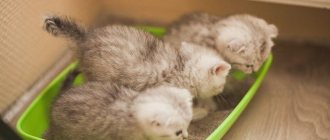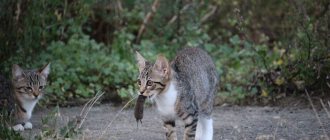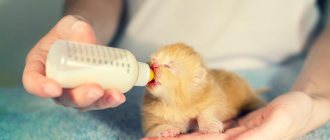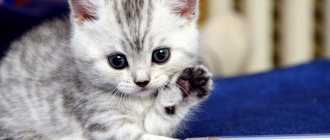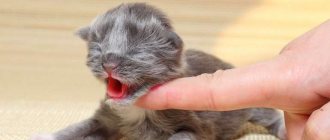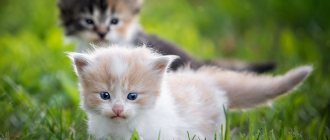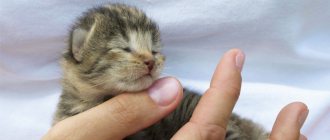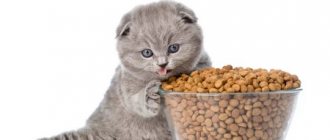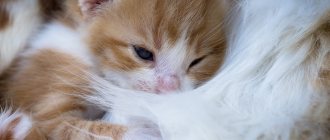What will you learn from the article?
- Kitten feeding regimen
- What foods can you feed a kitten?
- What to feed a one-month-old kitten (up to 1 month) What foods should you not feed a kitten
- Dry food for kittens
This article will help you learn how to feed your kitten correctly , calculate the diet, and avoid giving junk food.
Find out what food should be supplied to a small body in order for it to grow into a big, handsome cat.
What dangers await kittens at the bowl?
- unbalanced diet
Improper feeding affects the growth and development of the baby, leading to external defects and internal problems, and sometimes even death.
- poorly selected nutrition
The wrong choice of ready-made food, natural nutrition that causes allergic reactions - all this also negatively affects the growing body.
It is also important not to forget about a certain feeding schedule that is different from the schedule of an adult cat. Scary? Don't be shy, we'll figure it out!
Kitten feeding regimen
First, it is important to understand WHEN to introduce complementary foods and how often to feed the kitten. You, of course, can be guided by the kitten's hungry look, but it is better not to awaken the beast in him, and 3-4 weeks after birth, begin to gradually feed the baby.
By 4 weeks of age, a stable eating schedule should be established.
The baby should receive additional feeding 4-7 times a day.
But there are stalemate situations when kittens need additional feeding much more often.
How many times a day to feed:
- age up to 2 weeks – 10 times a day (with night coverage);
- feeding a one-month-old kitten – 8 times a day (including the night);
- 1 – 2 months – 7 times a day (night is already excluded);
- 2 – 3 months – 6 times a day;
- 4 months – 5 months – 5 times a day;
- 5 – 9 months – 4 times a day;
- 9 – 12 months – 3 times a day;
- Feeding kittens from 1 year of age becomes twice a day (for example, 9:00 – 21:00).
How much should a kitten receive per day?
- Age 1 week – 30 ml per 100 g of kitten weight;
- 2 weeks – 38 ml per 100 g of kitten’s weight;
- 3 weeks – 48 ml per 100 g of kitten’s weight;
- 4 weeks and subsequent – 48-53 ml per 100 grams of kitten weight.
Of course, it’s easy to calculate the amount of feed based on the items already proposed, but we’ll make the task easier and give a few numbers:
- At 1.5 months, a baby needs about 120 grams of food per day;
- We feed a two-month-old kitten more - 160-180 grams per day;
- During the period of active growth (3 months - 6 months), the daily food intake is 180-240 grams, with at least 40 grams of meat;
- A six-month-old baby needs up to 180 grams of food per day;
- At 10-12 months, the period when the kitten’s activity decreases, the daily food intake is 150-200 grams.
It is important to give vitamins to your pet. Read what vitamins to choose for a kitten.
Age 3-4 weeks
The transition from mother's milk to adult food is no less important than feeding infants. The restructuring of eating habits occurs gradually, along with the growth of the whole organism.
If the baby refuses the food offered, then he probably has enough liquid nutrition, and the transition to an adult diet should be postponed for a couple of days.
In order not to “disrupt” the gastrointestinal tract of children, it is necessary:
- Complementary feeding with adult food should begin at 3 weeks of age, but the main food for this period remains breast milk or the usual formula;
- add a new product to the diet little by little, starting with feeding once a day and increasing the number of complementary foods to 3 times a day by the age of one month;
- Give all food soft and warm.
Natural nutrition
Suitable complementary food for a 3-week-old kitten is lean veal, but not minced, but in the form of scrapes. To do this, well-frozen meat is scraped across the grain with a sharp knife to form thin plates.
The first portion of meat in your life should not exceed the size of a pea. Usually kittens are happy to try treats from their owner’s fingers, but picky cats are advised to open their mouths and smear a small amount of meat puree across the roof of their mouth.
In addition to scrapers, children are offered cream and liquid milk porridge (rice and oatmeal).
Industrial feed
High-quality dry food and canned food for kittens are designed specifically for a trouble-free transition of babies to adult food. They contain useful substances necessary for a growing body and relieve stress on the digestive tract, as well as vitamins and minerals, amino acids and antioxidants that strengthen the immune system.
Royal Canin Babycat 34 has proven itself to be excellent, consisting of small pieces with a delicate texture, which for babies aged 3-4 weeks are soaked in warm boiled water to a pulp.
At first, a small amount of prepared food is simply placed in the kitten’s mouth and smeared across the palate, repeating this procedure until the babies begin to lick the food from the bowl on their own.
What foods can you feed a kitten?
Remember that the food you put in your kitten's bowl should never be hot or cold. It is optimal if the food is at room temperature.
It is important to remember the consistency of food - it is better if the first portions are mushy and do not contain solid pieces. At home, a blender or an ordinary grater for milking vegetables will help with this.
So, what to feed a kitten:
- Meat. It can be raw, boiled, frozen and scalded. 60-80% of a kitten's daily diet comes from lean meat. What kind of meat is suitable for a kitten - see the table below;
- Liver. Offered once every 1-2 weeks;
- Porridge. In their pure form, the kitten is unlikely to be interested in them, but adding meat or vegetables radically changes the matter. Mix porridge with meat in a 1:2 ratio;
- Vegetables. Fresh or boiled;
- Eggs. What do kittens eat from eggs? Exclusively yolk. It is useful to give a raw yolk to a kitten once a week. Pay special attention to quail eggs - they are very healthy and quail eggs can be given whole, without separating the white from the yolk;
- Fermented milk products with low fat content;
- Brewer's yeast;
- Oil. Experts recommend avoiding vegetable oil and replacing it with Vaseline.
What to do if the kitten does not want to eat on its own?
You can expand your baby’s diet with baby meat puree.
Usually, by the age of one month, the cat herself begins to try to accustom her cubs to food. Owners can purchase ready-made baby meat puree to help their pet. A few days later - vegetable. It is permissible to prepare food yourself with a consistency close to gruel. A kitten who has not yet figured out how to eat without help can smear food across the roof of his mouth.
A good method is to offer a treat by hand. First, drop a little gruel on your finger and let it lick off. Gradually move your hand to a bowl with the same product. Another option is to spoon feed, gradually moving to a bowl. There is no need to force-feed the kitten; you may have to postpone introducing food until the next day. Dry complementary foods are fed well soaked in water. Professional nutrition for kittens from the 1st month of Royal Canin Baby Cat will help solve the problem of self-feeding. An appetite stimulant is a great way to help train a kitten to a bowl. Recommended preparations for short-term use: catnip, 8 in 1 Excel Kittyvite Vitamin paste.
What to feed a one-month-old kitten (up to 1 month)
A well-fed kitten either sleeps peacefully or quietly sucks the cat. But if kittens crawl around their mother, refuse the nipple, squeak and grab an outstretched finger - these are signs that the child is hungry.
Where to start with complementary feeding or full feeding of a week-old pet?
Prepare a bottle with a nipple, a dropper or syringe without a needle, and a special mixture designed to replace cat milk for a week-old kitten.
Here are some simple recipes on how to feed small kittens at home:
- Raw egg yolk + half a liter of concentrated milk
- Dry yeast (2.5 g) + whole milk powder (15 g) + whole cow's milk (50 g)
- Hard-boiled egg + beaten egg white + vegetable oil (1 g) + grape sugar (4 g)
- Half an egg yolk + corn oil (teaspoon) + whole milk (50 ml)
These and other recipes will also be useful if the kitten grows up without a mother cat and (correctly), its feeding is entirely your responsibility.
Read about recipes for feeding kittens up to a month without a cat
What foods should you not feed your kitten?
- Dry or wet food. There is no unanimity on this issue; rely on your own prudence and intuition. Therefore, here we put a question mark – ?
- Cow's milk. It is better to replace it with goat milk - it is not so fatty for the baby’s digestion. If you can’t get goat milk, then for very small kittens you can buy special powdered milk in pet stores
- Fermented milk products with high fat content
- Fish. In principle, children should not be given fish at all, but theoretically, sea fish is not harmful. Freshwater is prohibited, especially raw water, as it provokes the formation of urolithiasis and can become a source of infection with worms
- Salt, spices
- Sausages
- Potatoes are not at all digestible by the stomach of a domestic cat, so they are not given in any form.
- Legumes. Soy, peas, beans are not digested by the intestines and as a result we get bloating and fermentation in the intestines
- Cheese - due to its fat content
- Pork
- Sweets
- Chocolate. This particular sweet contains theobromine, a poison that causes severe poisoning and death in cats.
- Flour
- Mixed diet is harmful for kittens
Read more about what not to feed.
Age 0 to 3 weeks
At first, babies are entirely dependent on their mother, but if the cat does not have enough milk or the kittens are orphaned for some reason, the person takes on the function of nurse.
The most important point in caring for newborn kittens is the feeding regimen, as well as the portion size and composition of the mixture. Negligence in preparing a diet can lead to a malfunction of the digestive tract and an irreparable deterioration in the baby’s vital signs.
You can determine that kittens do not have enough food based on several signs:
- babies gain weight poorly or not at all;
- the whole body looks narrow and thin, the tummies are sunken;
- kittens are restless, make sharp whining sounds, but subsequently become apathetic, weakening every hour;
- the skin loses its elasticity due to progressive dehydration, muscle tone weakens, and vital processes stop.
To feed infant kittens, choose one of the cat's milk substitutes, or prepare a suitable mixture at home.
Cat milk replacers
Specialized dry mixtures are sold in pet stores and veterinary pharmacies; they are balanced in composition and contain all the necessary nutrients. They are suitable for kittens of all breeds and do not require much time to prepare: just dilute the required amount of the mixture with warm water and stir well.
It is preferable to choose products from well-known global manufacturers that produce premium and super-premium food, for example:
- Beaphar Kitty-Milk;
- Royal Canin Babycat Milk;
- Nutri-Vet Kitten Milk;
- Kittenmilch cdVet.
It is not recommended to buy:
- low-quality animal formulas with added starch;
- milk substitutes with fat content below 8%;
- food for human infants containing sugars and a completely different set of ingredients.
Self-cooking
Food suitable for feeding infant kittens can also be prepared at home. Caring owners can offer several proven recipes:
- To 200 g of whole cow's milk add 200 g of goat's milk, as well as 2 egg whites, whisking thoroughly in a bowl.
- Pour ½ tsp into 100 ml of goat milk. refined corn oil and half a raw egg yolk, stirring until smooth.
- Add ¼ tsp to 250 ml of hot cow's milk. fresh bone meal, 50 ml of natural condensed milk without sugar and 25 ml of boiled water. The resulting mixture is filtered and cooled.
- Add 1 drop of Trivit liquid vitamins to 100 ml of natural coffee cream (fat content 9%).
Portion calculation
The serving size for each feeding is calculated based on the age and weight of the baby:
- from 0 to 4 days – 60 ml of mixture per 200 g of live weight;
- from 5 to 13 days – 76 ml/200 g body weight;
- from 14 to 24 days – 92 ml of mixture per 200 g of weight;
- from 25 to 30 days – 106 ml per 200 g of weight.
Basic feeding rules
The owner should adhere to a number of rules:
- It is necessary to feed kittens every 2 hours, and if there is a lack of mother's milk, 5-6 feedings per day are sufficient;
- a fresh portion is prepared from powdered milk replacer each time, and the “homemade” mixture of natural products is stored in the refrigerator for no more than 2 days;
- food is served to babies warm from a bottle with a narrow nipple or through a pipette (with a hole) placed on a syringe;
- nipples, bottles and pipettes are thoroughly washed and dried after each feeding.
Can I give it to a kitten - food table
| Product | Can I give it to a kitten? |
| Banana | No |
| Borsch | No |
| Broccoli | Yes |
| Buckwheat | Yes |
| Baby food | Yes |
| Potato | No |
| Kefir | Yes |
| Food for adult cats | No |
| Semolina | No |
| Milk | No |
| Carrot | Yes |
| Oatmeal | Yes |
| Cucumber | Yes |
| Liver | Yes |
| Tomato | Yes |
| Rice | Yes |
| Fish | No |
| Ryazhenka | Yes |
| Sour cream | No |
| Soup | Yes |
| Raw meat | Yes |
| Cottage cheese | Yes |
| Grass | No |
| ground meat | Yes |
| Bread | No |
| Chocolate | No |
| Apple | Yes |
| Egg | Yes |
Help the cat
The pet pleased the owners. Squeaking lumps were born. If the cat has given birth for the first time, the litter should not be too large. From 3 to 6 kids is ideal.
The mother is able to feed this number of kittens normally. If there are more of them, you will have to introduce complementary foods for the kittens, or, more correctly, supplementary feeding.
For these purposes, you can buy a cat's milk replacer. It is sold in good pet stores. It's not cheap, let's warn you right away.
You can make a substitute yourself. It is different from the store bought one, of course. But it has been tested by time and by more than one “cat person.”
- Take a liter of milk.
- Add two yolks to it.
- A teaspoon of sugar also goes here.
- Mix everything.
- Feed the kitten the heated mixture.
Features of the diet by month
Features of feeding a kitten aged 2 – 4 months
By this age, the kitten has already cut its teeth and it is time to transfer it to autonomous feeding, teaching it to eat and drink from bowls on its own. The kitten's growth is very active, its skeleton is being formed and strengthened, and the gastrointestinal tract is finally formed. What to feed a 2 month old kitten? The baby's diet should be as fortified as possible and especially rich in protein.
Features of feeding a kitten aged 4 – 6 months
At this age, the baby is actively gaining weight, so you need to make sure that the basis of the diet is not foods that are stored as fat, but those that increase muscle mass.
The baby's jaw has already formed and pieces of meat, beef or chicken offal can be given not ground, but cut into pieces. What else do kittens eat at this age? It is recommended to gradually add fermented baked milk or yogurt to low-fat fermented milk products.
Features of feeding a kitten aged 6 – 10 months
During this period, the daily number of feedings is actively reduced. The kitten's growth becomes less noticeable, but its taste preferences are already emerging. Do not indulge the cat's whims and do not give your teenager prohibited foods or food from the table. At this age, you can treat your pet with low-fat sea fish from time to time.
Read what should be in your veterinary medicine cabinet at home.
Water in the diet
The process of transitioning from cat milk or milk replacer involves gradually increasing your drinking water intake. Water is very important to keep kittens healthy and active. At about 4 weeks of age, as soon as the kittens begin to eat solid food, they need to have access to clean, fresh water.
It is advisable not to use a plastic bowl; it should be made of metal, glass or porcelain. It is better to place the bowl a little away from the place where the kittens eat. You can place several bowls of water throughout the apartment. A good solution would be to purchase a special drinking fountain.
Water is very important for a kitten's health
Consequences of poor nutrition
Proper nutrition for kittens = future health of the cat.
It is not for nothing that at the beginning of the article we focused on how important it is for the kitten to receive a balanced diet.
An imbalance of nutrients (microelements, vitamins, etc.) leads to serious problems with the health of the animal:
- Diabetes
Kittens sometimes have so-called juvenile diabetes. There are individuals who are genetically predisposed to it, so don’t be reckless and don’t provoke the manifestation of the disease with improper nutrition
- Feline vitamin deficiency
– lack of vitamin E (tocopherol) leads to a deterioration in the quality of the coat, irreversible changes in muscles and the development of infertility in the future.
– lack of vitamin C undermines the immune system and can lead to scurvy;
– vitamin D is responsible for calcium-phosphorus metabolism and prevents the development of rickets;
– vitamin A deficiency leads to digestive disorders and development of reproductive organs.
- Allergy
- Poisoning
As we wrote above, there are foods that are literally poison for cats (chocolate, onions, garlic). And it’s good if loose stools are the only and quickly relieved symptom of poisoning. Often, consuming these products can be fatal for your pet.
Of course, this is not the entire list of problems threatening the baby, but we have highlighted the main points.
How to train a kitten to eat on its own
Nutrition is one of the most important instincts necessary for the survival of animals. Therefore, healthy kittens by 3 weeks of age begin to actively take an interest in food. All that remains for the owners is to encourage the baby to become independent and ensure his safety. It is recommended to start training with milk. The finger is dipped into a bowl of drink and the pet is given the opportunity to sniff and lick it. Then the baby is quietly pushed towards the bowl.
After a few days, the pet will learn to eat on its own. At first, a one-month-old kitten is fed food that has a soft, porridge-like consistency. Then the baby is introduced to finely chopped foods and solid foods. In order for a one-month-old kitten to grow into a strong, harmoniously developed cat with luxurious shiny fur and good immunity, it needs to be fed properly.
Inadequate nutrition has a bad effect not only on the appearance, but also on the health of the pet.

